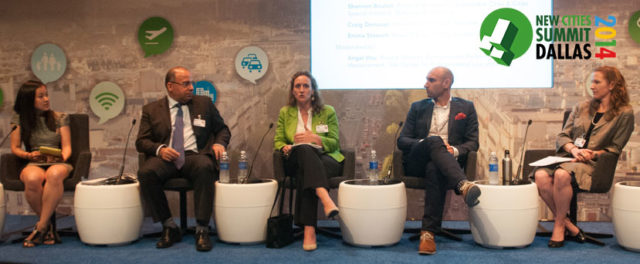Technology and the Green City
September 29, 2014 — Blog
This post is part of our Re-imagining Cities discussion series, following the third edition of the NewCities Summit in Dallas in June 2014.
How do we define green cities? Is a green city different from a smart city What is the role of technology in the green city? What are some of the successes and failures in integrating technology in green cities?

Craig Donovan began by stating that a green city is both a smart and sustainable city. Emma Stewart suggested that the smart city construct is possibly counterproductive, certainly elusive. Smart cities can lead to two situations: either we spend too much money and find out that data states the obvious, or we invest too much time into actually getting data.
Charbel Aoun insisted on the importance of putting people at the center of the green city and of having greener communities surrounding green cities in order to incentivize improvement. Reacting to this, Shannon Bouton defined ‘smart cities’ as cities that use technology-driven solutions to solve problems. She noted that increasing the efficiency of a service is better than just expanding it, as seen with cameras on traffic lights, which can improve traffic efficiency instead of having to widen roads.”
Pursuing the conversation on technology, Emma Stewart stressed the importance of data plans. Only a minority of cities has one, leading to agencies battling each other for supremacy: the pitfalls of the data network are human, not technological.
In tandem, Charbel Aoun hypothesized that most cities are not yet mature enough to fully integrate technology. He also asserted that no one single company could take on the challenge of completely integrating technology into a city. Shannon Bouton then stated her concern about the tradeoff between technology and infrastructure. The desire for innovation and modernity can drive job growth, education and investment. Therefore, investing in technology is an option to be considered.
Going further, Shannon Bouton stressed that leasing rather than owning technology is an interesting emerging option. Charbel Aoun insisted on the importance of collaboration. Whereas companies used to sell fully integrated systems, it is now common to sell just a single service.
Craig Donovan suggested that the transition from ‘things’, such as Blackberry phones, to servers, such as the cloud, would be beneficial. He agreed with Bouton on the importance of a universal platform, but expressed concerns about the difficulties of making this transition right now.
Emma Stewart again lauded the significance and usefulness of the cloud. She argued that its strength lies in its ability to tap into vast amounts of simulation power, preventing the need to go through rote calculations. She closed the discussion by providing three simple steps to obtain integration: simulate what the different options are, calculate what the various design scenarios could be, and then legislate. She claimed that if we use technology to better tailor policies, we would reach a winning formula.
Speakers
- Charbel Aoun, Senior Vice President, Smart Cities, Schneider Electric – @CJAoun
- Shannon Bouton, Practice Manager for Sustainable Cities & Cities Special Initiative, McKinsey & Company
- Craig Donovan, Head of Sustainability Research, Ericsson Research – @EricssonNA
- Emma Stewart, Head of Sustainability Solutions, Autodesk
Moderator: Angel Hsu, Project Director, Environmental Performance Measurement, Yale Center for Environmental Law and Policy – @ecoangelhsu
